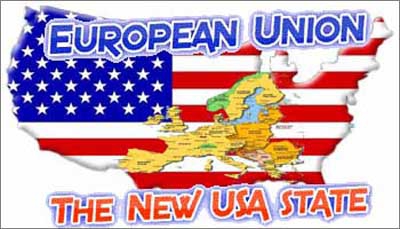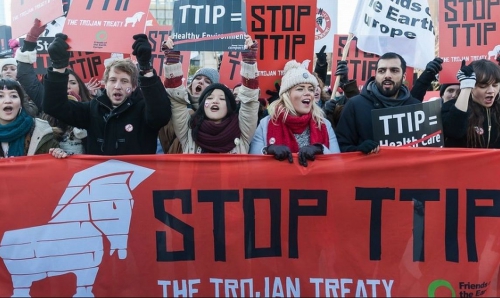TTIP and TPP vs Eurasian Integration
If official reports are to be believed, US President Barack Obama’s recent visit to Europe covered everything except for what was actually at the heart of the discussions, namely the Transatlantic Trade and Investment Partnership (TTIP).
For Obama, whose foreign policy successes look pathetic even compared to those of his predecessor George W Bush, it is vitally important that he finishes his presidency with a bang, especially since, by his own admission, prospects for the future of the TTIP will be extremely uncertain once the White House changes hands.
And it is not even that Donald Trump, who is openly critical of the global ambitions of the current American elite, has a chance of becoming president. There will also be problems should Hillary Clinton become president, even though, like Obama, she represents the interests of transnational corporations and is a great believer in the idea of US global dominance. The election campaign currently underway in the US has already shown that the electorate is willing to place the interests of the US as a nation state above the imperial ambitions of the elite and large corporations. Trump is not the only one to have expressed this trend, there is also Bernie Sanders and even, to some extent, the number two in the Republican race, Ted Cruz. Even if she wins, therefore, Hillary Clinton will be forced to take this point of view into account, particularly as it will only gain her supporters over time.
Europe’s leaders (with the exception of German Chancellor Angela Merkel and UK Prime Minister David Cameron, perhaps) are also not full of enthusiasm at the prospect of their countries becoming colonial appendages to a US monopoly, especially as the majority of countries in Europe also have elections coming up. So if Obama actually succeeds in concluding the TTIP, he will be able to feel like a winner. Along with the Trans-Pacific Partnership (TPP) agreement signed between the US and 11 countries of the Asia-Pacific region in October 2015, the outgoing US president will be able to take credit for creating a hugely powerful American-centric system that engulfs the whole of Eurasia from the West and the East and subordinates a number of developed or successfully developing national economies to American (or rather multinational) capital, with a view to the strangulation or subsequent subordination of those countries left out of the TTIP and TPP – primarily China, Russia, India and a number of others.
In addition, America’s attempts to create the TPP and TTIP, which are designed to break the balance of interests in Eurasia completely, are taking place amid strengthening integration processes within Eurasia itself. The joint statement issued by Russian President Vladimir Putin and Chinese President Xi Jinping in May 2015, during the 70th Anniversary of WW II Victory celebrations, on the integration of the Eurasian Economic Union (EEU) and the Silk Road Economic Belt opened up huge possibilities for uniting the economies of all the countries in Greater Eurasia. And the process of India and Pakistan’s accession to the Shanghai Cooperation Organisation (SCO) as fully-fledged members (with the possibility of Iran also joining the SCO in the near future) that began in July of the same year simply complete these integration processes.
 Moreover, the integration initiatives in Eurasia are not limited to the EEU, the Silk Road Economic Belt and the SCO. In this context, the Eurasian initiative of South Korean President Park Geun-hye, Kazakhstan’s ‘Nurly Zhol’ programme and Mongolia’s Steppe Route project are also worth mentioning. The fundamental difference between all of these projects and the TTP and TTIP projects being promoted and financed by the US is as follows. The main objective of the TPP and TTIP (besides subordinating the member countries’ economies) is to impede the economic growth of the leading Eurasian countries, primarily China and Russia, and prevent their integration into the Asia-Pacific Region and Eurasia. Thus the TPP and TTIP initiatives are exclusive, they deliberately exclude America’s main economic and political rivals. In contrast, the EEU, the Silk Road Economic Belt, the SCO and all the other projects and initiatives mentioned above are by definition inclusive. They are not only open to participation by all the countries in the region, but would simply be unrealisable if just one of the countries located in an area where major infrastructure projects were being implemented was unable, for whatever reason, to take part.
Moreover, the integration initiatives in Eurasia are not limited to the EEU, the Silk Road Economic Belt and the SCO. In this context, the Eurasian initiative of South Korean President Park Geun-hye, Kazakhstan’s ‘Nurly Zhol’ programme and Mongolia’s Steppe Route project are also worth mentioning. The fundamental difference between all of these projects and the TTP and TTIP projects being promoted and financed by the US is as follows. The main objective of the TPP and TTIP (besides subordinating the member countries’ economies) is to impede the economic growth of the leading Eurasian countries, primarily China and Russia, and prevent their integration into the Asia-Pacific Region and Eurasia. Thus the TPP and TTIP initiatives are exclusive, they deliberately exclude America’s main economic and political rivals. In contrast, the EEU, the Silk Road Economic Belt, the SCO and all the other projects and initiatives mentioned above are by definition inclusive. They are not only open to participation by all the countries in the region, but would simply be unrealisable if just one of the countries located in an area where major infrastructure projects were being implemented was unable, for whatever reason, to take part.
And here we see the following picture. In addition to creating certain frameworks that are under the complete domination of the US (and thereby working for the completely hopeless goal of preserving the unipolar world order), forces that have no interest in the realisation of inclusive integration processes in Eurasia are attempting to directly torpedo these initiatives. If we were to compare a map of the hot spots in Eurasia with a map of the Silk Route’s proposed routes, for example, we would see that most of the trouble spots are located along these routes (along with the routes intended for the development of other integration projects), as well as at the junctions and the most crucial points.
These include the territorial disputes (between China and its neighbours in East and Southeast Asia, for example, or between India and Pakistan), ethnic conflicts (in Myanmar, Nepal and the Pakistani province of Balochistan), civil wars (in Syria or Ukraine), and direct foreign military intervention (in Afghanistan and Iraq) that have placed these countries on the brink of collapse, piracy in the Strait of Malacca and the Horn of Africa, and much more. And it can hardly be considered a coincidence that the conflict in Nagorno-Karabakh (which is undoubtedly being orchestrated by forces outside of the country) once again flared up just when the situation surrounding Iran (which, until recently, was one of the main obstacles to Eurasian integration) was beginning to more or less get back to normal. We should also mention here the enormous efforts of foreign (primarily American) NGOs in Central Asia, where a huge number of conflicts and potential conflicts are lying dormant or smouldering. And thus we get a complete picture of how, in addition to engulfing Eurasia in its own projects, the US is seeking to weaken the continent’s unity in favour of the old principle of ‘divide and rule’.





 del.icio.us
del.icio.us
 Digg
Digg
Les commentaires sont fermés.